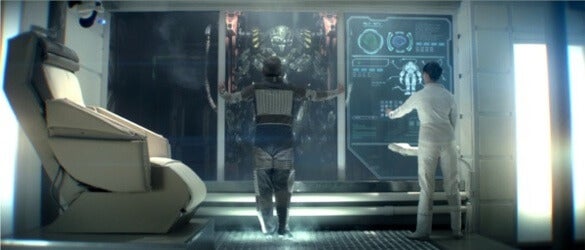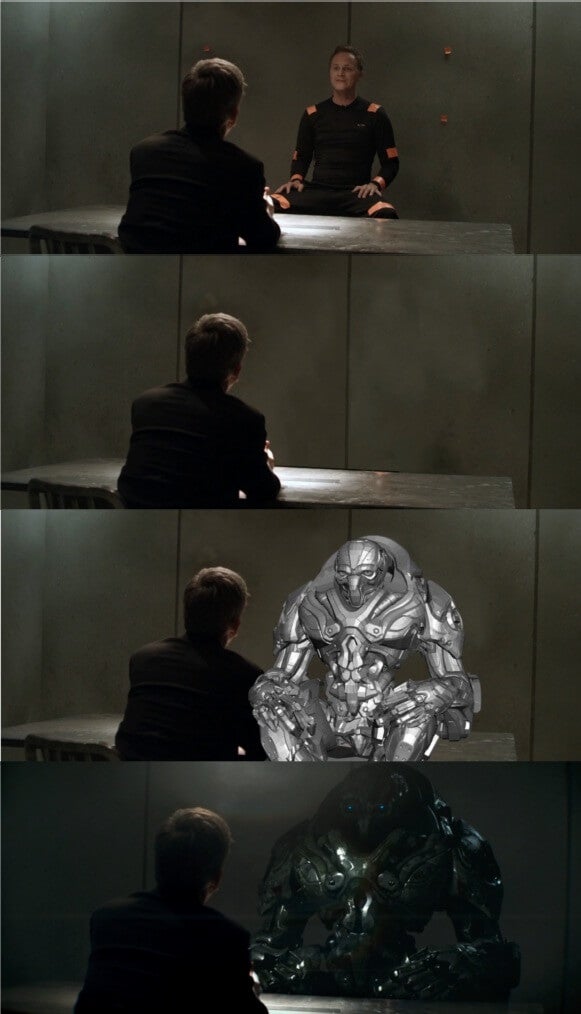
What good is a killing machine that’s developed a conscience? In Aaron Sims‘ exciting new short film Archetype, RL7 is a devastatingly powerful military robot that seems to be remembering its past life…as a human and loving father. Running under seven minutes, the brief movie (embedded in its entirety below) grabs its audience with stunning visual effects and an immersive futuristic world. That’s no surprise considering Sims’ impressive credentials in film – his visual effects and design can be seen in Rise of the Planet of the Apes, Transformers: Dark Side of the Moon, Green Lantern, and dozens of other blockbusters from the past three decades. Archetype is Sims’ breakout project, a self-produced short film that is aimed at attracting the right attention so that it can be extended into a full length feature. Singularity Hub spoke with Sims about the allure of robots with memories, the process of creating your own movie, and how Hollywood will be changed by the coming democratization of making films.
Presented with permission by Aaron Sims, here is the short film Archetype:
Sims got started in Hollywood in the 80s working on special makeup effects with the legendary Rich Baker. In the 90s he broadened his scope to general visual effects, incorporating more computer technology, and working for Academy Award winner Stan Winston (Jurassic Park, Aliens, Predator, etc). By the early 2000s Sims had garnered enough attention for his pioneering efforts in visual effects that he became the lead character designer for Steven Spielberg’s Artificial Intelligence: A.I. Sims’s willingness to embrace and innovate digital technology has helped the Aaron Sims Company become one of the leading design and effects firms in Hollywood today. Their portfolio includes films like 30 Days of Night, The Golden Compass, I Am Legend, The Day the Earth Stood Still, The Chronicles of Narnia: Prince Caspian, The Incredible Hulk, The Green Lantern…the list goes on.
Unsurprisingly after all his years in Hollywood, Sims had his own idea for a film. The seed for Archetype started with the vision for the robot interrogation scene. Sims mentioned how impressed he’s been with research out of MIT on AI and social machines. He thinks there is “something so amazing about what might become of [humanity] as we live forever inside machines, not just in robots. What makes us a person?” RL7, a military robot that has somehow been created using a real human with real memories, is a comment on that question and how we may (or may not) think of such entities as “people”.

Sims was a little reluctant to go into greater details about how RL7 was made, why he was made the way he was, and what he’ll do after he escapes. All of those questions, after all, are likely to be answered in a feature length version of Archetype, and Sims hopes to make that movie. In fact, the Archetype short reads as a sort of pitch – a seven minute preview of a film that a mainstream or independent studio may hope to pick up and produce. Sims has already received interest to that end, but he was measured in his hopes. Studio execs find it hard to “open doors for new concepts. It’s a business, and risk is difficult to take. That’s why you see so many remakes and sequels.”
Which is why it’s promising to have a project like Archetype get so much positive attention. Whether or not the short film gets picked up to be extended into a feature, Sims work shows how modern technology and innovative filming techniques can help new moviemakers get a foot in the door. Sims says that most of Archetype’s production was pretty standard: storyboards, shot planning, etc. On occasion, however, he had to get creative – limiting tracking for special effects shots by going back and shooting the camera shake separately. “Part of film making is in some ways tricks…thinking outside the box, and coming up with new techniques, to develop concepts on how to do things inexpensively.” If shot as a traditional Hollywood project, Archetype could probably have cost millions. Yet Sims leveraged his friendship in the industry to help create a film with a visual style equal to that of any mainstream production you’d see in a theater, only on a miniscule budget. The script for Archetype was appealing enough to attract actors like David Anders (RL7) and Robert Joy (Jones) so they would work for very little pay. Likewise for Sims’ colleagues who spent countless hours working on the special effects.
But what if you’re an aspiring filmmaker who doesn’t have decades of experience working in Hollywood? Sims thinks that opportunities are opening up there as well. “The software is easier, more accessible, open to artists. Same with cameras.” Sims thinks that in the future, we could see projects like Archetype (short films aiming to attract attention and become something more) quite often. “Not only short films, but independent features. Anybody with a dream or idea, the tools are becoming available…It will be common…and I should say that I’m not the first. It’s an exciting time for everyone with dreams and passions to make films.”
I have to agree with Sims. While Archetype’s production value stands out as above and beyond most of the free films you’ll find online, there are many other examples of independent up-and-coming film makers exploring non-traditional avenues towards feature length movies. Freddie Wong and Brandon Laatsch not only produce weekly one to two minute shorts on YouTube, they also publish videos to discuss the special effect techniques they use to help their viewers with their own projects. As a whole, the upcoming generation of internet-enabled movie makers can do more on their own, and share their work much more easily than their predecessors. Aarons Sims and his team are the forefront of independent special effects, as seen with Archetype. Yet video editing and special effects software will only get better, and soon we could have even more world class independent projects making their way to your screen. Hopefully that blend of video technology and human creativity will be mirrored in the subject matter of the films themselves.
I mean, who doesn’t love watching robots go on quests of self-discovery?

[image and video credits: Aaron Sims Company]
[source: Aaron Sims]



